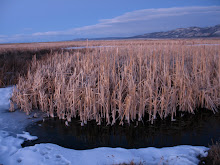 Embarking on this walk at dusk is immediately a different experience. It is a variable show of lights, first illuminating the world in gold, then quickly shifting into a display of powdery mountains glowing pink. The beautiful snowfields left by the recent storms are like ready pallettes, readily receiving the colors cast by the setting sun. A thick bank of clouds stretching north-south like a curtain behind San Antonio mountain expedites the transition from light to dark.
Embarking on this walk at dusk is immediately a different experience. It is a variable show of lights, first illuminating the world in gold, then quickly shifting into a display of powdery mountains glowing pink. The beautiful snowfields left by the recent storms are like ready pallettes, readily receiving the colors cast by the setting sun. A thick bank of clouds stretching north-south like a curtain behind San Antonio mountain expedites the transition from light to dark.As I duck beneath the barbed wire fence, I feel the temperature dropping as the light fades. In this light, footpints in the snow stand out. There is a set of rabbit and perhaps kangaroo rat tracks that cross one another, leaving a detailed map of their route. I can see individualized toes and I marvel at their delicacy.
 Although some of this snow came only yesterday, the warm temperatures today have already melted patches. This quick melt gives rise to the phenomena of floating ice. Extending out from a thick patch of snow is a crust of ice 1-2 inches above the ground. My favorites are suspended footprints, mostly bootprints, crunched together into an icy lattice from under which the snow melts, leaving the suspended, translucent pattern.
Although some of this snow came only yesterday, the warm temperatures today have already melted patches. This quick melt gives rise to the phenomena of floating ice. Extending out from a thick patch of snow is a crust of ice 1-2 inches above the ground. My favorites are suspended footprints, mostly bootprints, crunched together into an icy lattice from under which the snow melts, leaving the suspended, translucent pattern.The road leading north to the old cow feeding barn feels longer as I traverse it alone. I notice that there are two other sets of boot prints that have gone this way. I like to think of sharing the pleasures of this walk with others. I gaze at Blanca, now camouflaged with the gray dusk sky. Only 5 minutes earlier she was illuminated, a colossal soft desert rose to the north.
 I arrive at the edge of the wetlands, grass thickens and snow thins underfoot. The loud crunching of snow fades into the gentle swishing of grass cradling my boots. AS I enter the wetlands, I notice that many of the puffy cattail heads are missing, shorn cleanly off. Who has eaten them? There are no paths into the wetlands describing a lumbering cow. If it was a stick animal, the evidence of their entry has already closed behind them. Perhaps a delicate deer?
I arrive at the edge of the wetlands, grass thickens and snow thins underfoot. The loud crunching of snow fades into the gentle swishing of grass cradling my boots. AS I enter the wetlands, I notice that many of the puffy cattail heads are missing, shorn cleanly off. Who has eaten them? There are no paths into the wetlands describing a lumbering cow. If it was a stick animal, the evidence of their entry has already closed behind them. Perhaps a delicate deer?My attention shifts to the wetlands on the southside of the mounded, at-one-time-used causeway through the middle of the wetlands. A group of Red-Winged Blackbirds has gathered in the reeds for the night, their forms dark in the reeds against the fading light of dusk. I stand still listening and waiting. Kibbe, our dog, follows suit, frozen in attention, ears cocked and nose raised. The Red-Winged Blackbird (Agelaius Phoeniceus) most likely inhabits these wetlands year-round, at least frequenting them as a good source of seeds and bugs (their favorite foods). According to The Sibley Field Guide to Birds of Western North America, they both nest and roost in wet, marshy or brushy habitats and it is common for them to forage or roost in large flocks (as I have seen tonight).
 When we begin walking again the blackbirds startle and half the flock lifts off into a furious unity of swooping. I think of swarming and the many instantaneous group observations, communications and behavior modifications occurring to keep formation in motion - shifting, expanding and contracting like a collective lung. As the sound of their wings rain down on me, I take in my breath.
When we begin walking again the blackbirds startle and half the flock lifts off into a furious unity of swooping. I think of swarming and the many instantaneous group observations, communications and behavior modifications occurring to keep formation in motion - shifting, expanding and contracting like a collective lung. As the sound of their wings rain down on me, I take in my breath. We walk west to our destination and enjoy the panorama. The light is the most delicate I've seen here. We've reached the tipping point. Dusk quickly fades into night. I can feel the half-darkness muffling my senses. I begin to see the movement of forms just beyond my eyes' reach. It is a nocturnal haven now and time for diurnal creatures like me to return home.
We walk west to our destination and enjoy the panorama. The light is the most delicate I've seen here. We've reached the tipping point. Dusk quickly fades into night. I can feel the half-darkness muffling my senses. I begin to see the movement of forms just beyond my eyes' reach. It is a nocturnal haven now and time for diurnal creatures like me to return home.





the light and feeling of dusk is so perfectly captured here. Kyce
ReplyDelete